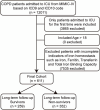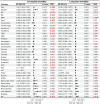Association between iron homeostasis and prognosis in patients with chronic obstructive pulmonary disease: a retrospective analysis from MIMIC-IV database
- PMID: 40584712
- PMCID: PMC12202532
- DOI: 10.3389/fmed.2025.1610681
Association between iron homeostasis and prognosis in patients with chronic obstructive pulmonary disease: a retrospective analysis from MIMIC-IV database
Abstract
Introduction: Accumulating evidence indicates that inflammatory responses can alter iron-related biomarkers, such as serum iron, ferritin, transferrin, and total iron-binding capacity (TIBC). However, in the context of chronic obstructive pulmonary disease (COPD), characterized by airway inflammation, the relationship between its prognosis and iron-related biomarkers has not been comprehensively assessed.
Methods: Clinical data of 611 COPD patients from the Medical Information Mart for Intensive Care IV (MIMIC-IV) database were retrospectively analyzed. Associations between four iron-related biomarkers-serum iron, ferritin, transferrin, and TIBC-and both long-term and in-hospital mortality in patients with COPD were assessed using the Cox model and the Kaplan-Meier survival analysis. Moreover, receiver operating characteristic curves were used to further evaluate the prognostic predictive ability of these indicators.
Results: The results suggested that higher levels of serum iron and ferritin were significantly associated with poor long-term prognosis in COPD patients. However, higher levels of transferrin and TIBC may reduce the risk of long-term mortality, serving as protective factors. Furthermore, to a certain degree, these four indicators possessed predictive value for both long-term and in-hospital mortality in patients with COPD.
Conclusion: This study underscores the critical connection between iron-related biomarkers and the prognosis of COPD patients, contributing valuable insights for risk stratification and clinical management in this demographic. Future studies, both retrospective and prospective, should investigate the effects of dynamic fluctuations in iron-related biomarkers to enhance the treatment and management of COPD.
Keywords: MIMIC-IV database; chronic obstructive pulmonary disease; in-hospital mortality; iron homeostasis; long-term mortality.
Copyright © 2025 Dong, Xu, Yu, Zhang, Yuan, Tang, Xie, Zhang, Li and Wang.
Conflict of interest statement
The authors declare that the research was conducted in the absence of any commercial or financial relationships that could be construed as a potential conflict of interest.
Figures





References
LinkOut - more resources
Full Text Sources

